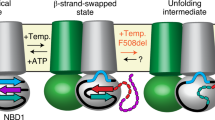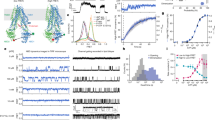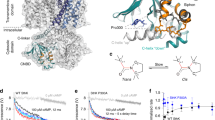Abstract
Phosphorylation controls the activity of ion channels in many tissues. In epithelia, the cystic fibrosis transmembrane conductance regulator (CFTR) chloride channel is activated by phosphorylation of serine residues in its regulatory (R) domain and then gated by binding and hydrolysis of ATP by the nucleotide-binding domains1,2,3. Current models propose that the unphosphorylated R domain serves as an inhibitory particle that occludes the pore1,2,4,5,6, much like the inhibitory ‘ball’ in Shaker K+ channels7,8; presumably, phosphorylation relieves this inhibition. Here we test this by adding an R-domain peptide to a CFTR variant in which much of the R domain had been deleted (CFTR-ΔR/S660A): in contrast to predictions, we found that adding an unphosphorylated R domain to CFTR-ΔR/S660A did not inhibit activity, whereas a phosphorylated R-domain peptide stimulated activity. To investigate how phosphorylation controls activity, we studied channel gating and found that phosphorylation of the R domain increases the rate of channel opening by enhancing the sensitivity to ATP. Our results indicate that CFTR is regulated by a new mechanism in which phosphorylation of one domain stimulates the interaction of ATP with another domain, thereby increasing activity.
Similar content being viewed by others
Main
We previously studied a CFTR variant, CFTR-ΔR/S660A, in which much of the R domain (residues 708–835) was deleted and the phosphorylation site was removed at Ser 660 by mutation to alanine4. This variant does not need to be phosphorylated in order to open in the presence of ATP, and addition of the cyclic-AMP-dependent protein kinase A (PKA) does not alter its open-state probability (Po). Based on those and other considerations, it has been proposed that the R domain inhibits the channel1,2,4,5,6,9. This model predicts that the activity of CFTR-ΔR/S660A should be similar to that of phosphorylated wild-type CFTR. However, when we examined the single-channel properties of CFTR-ΔR/S660A, we found that Po was 0.13 ± 0.01 (1 mM ATP, n = 7), much lower than that of phosphorylated wild-type CFTR (Po = 0.46 ± 0.02; 1 mM ATP, n = 17, P < 0.001). These results, which are similar to those described in a previous report4, indicated that the R domain might be more than just a plug that inhibits the channel. But deletion of the R domain in CFTR-ΔR/S660A could still have additional nonspecific effects on channel structure which might reduce activity. We considered, therefore, that the phosphorylated R domain might stimulate the channel and that the defective functioning of CFTR-ΔR/S660A is due to its lacking a phosphorylated R domain.
To test this idea, we added a recombinant R domain (R1, residues 645–834, similar to a peptide reported previously10) to the cytosolic surface of CFTR-ΔR/S660A and measured activity by using the excised, inside-out patch-clamp technique. Figure 1a shows that phosphorylated R1 stimulates the channel: that is, the current increases when the R domain is added in the presence of PKA (PKA phosphorylates R1 and related peptides10; S. Travis, unpublished results). Stimulation was reversed when R1 was removed. Figure 1b shows that R1 has no effect in the absence of PKA, indicating that it is the phosphorylated R domain that stimulates channel activity. Additional evidence that the effect of phosphorylation was on R1 rather than on CFTR-ΔR/S660A came from our finding that addition of phosphorylated R1 in the presence of protein-kinase-inhibitor peptide under conditions that block the effect of PKA11 gave similar results (43.2 ± 3.4% increase; n = 3). A different PKA substrate (‘Kemptide’; 10 µM (ref. 12) had no effect in the presence or absence of PKA (n = 4; results not shown). R1 had no effect on wild-type CFTR (Fig. 1c), perhaps because the endogenous R domain has a maximal effect or because steric hindrance from the endogenous R domain prevents interaction with R1. This latter possibility is consistent with our finding that phosphorylated R1 did not stimulate CFTR containing mutated phosphorylation sites (n = 3; not shown). Our results also suggest that the low Po found for CFTR-ΔR/S660A results at least in part from a lack of stimulation by a phosphorylated R domain, rather than from nonspecific structural changes. The fact that R1 did not increase the Po of CFTR-ΔR/S660A to wild-type CFTR values may be because the endogenous R domain is constrained in the correct orientation by the site of interaction; the interaction of exogenously applied R1 with CFTR-ΔR/S660A is probably less efficient. Our results contrast with a report that addition of an in vitro translation mixture containing a different unphosphorylated R domain (residues 588–858) inhibited wild-type CFTR channels in lipid bilayers5, but they do not preclude such effects under certain conditions.
a, b, Time course of Cl− current in excised, inside-out patches containing many CFTR-ΔR/S660A channels during addition of PKA and R1 (50 nM), as indicated by bars. Each data point represents mean current during a 10 s interval. ATP (1 mM) was present at all times. Similar results were obtained irrespective of the sequence of R1 and PKA addition. c, Effect of R1 in the presence and absence of PKA on current measured from CFTR-ΔR/S660A and wild-type CFTR. Wild-type CFTR channels were initially phosphorylated with PKA and ATP. Then R1 was added in either the continued presence of PKA or following its removal, as indicated. Note that once they are phosphorylated, wild-type channels remain active in the absence of PKA (ref. 11, and see Fig. 3b). For CFTR-ΔR/S660A, n is 10 and 9; for wild-type CFTR, n is 4 and 5, in the absence or presence of PKA, respectively. Asterisk indicates P < 0.01 compared to value in the absence of R1. Values are mean current measured between 10 and 12 min after addition of R1.
To find out how the phosphorylated R domain stimulates CFTR-ΔR/S660A, we investigated channel gating. Gating of CFTR can be described by the rate of channel opening into bursts of activity and the rate of closing from bursts13,14,15. Figure 2 shows that phosphorylated R1 increases the rate at which CFTR-ΔR/S660A opened into bursts, without affecting the rate of closure from bursts. These results predict that a decrease in phosphorylation of intact, wild-type CFTR would have the opposite effect, decreasing the rate of opening. We therefore tested the gating of CFTR variants in which endogenous R-domain serines were mutated to alanine. We studied four serine residues (Ser 660, 737, 795, 813) that are phosphorylated in vivo10,16,17. Mutation of the individual serines reduced Po, but to different extents: the S795A mutation had the largest effect and S737A had little or no effect in the presence of 1 mM ATP (Fig. 3a). Simultaneous mutation of all four serines (S-quad-A) also decreased Po. Moreover, when we removed PKA from wild-type CFTR, Po decreased, consistent with a previous suggestion that there is some phosphatase activity associated with the patch of membrane18,19,20. The serine mutations decreased the rate of channel opening without altering the rate of closing (Fig. 3c).
a, Example of continuous single-channel tracings before and at 10 min after the addition of R1. b, c, Effect of R1 on the rates of entry into and exit from a burst for CFTR-ΔR/S660A channels in the presence of PKA. Note that because they do not measure the fast closings during a burst, calculation of Po from the rates in b and c gives an overestimate of Po. Use of a 50% threshold-crossing method to determine Po gives values of 0.134 ± 0.015 and 0.189 ± 0.021 in the absence and presence of R1, respectively. Data were obtained between 10 and 12 min after adding R1. PKA was present under all conditions; n = 10 in the absence and n = 6 in the presence of R1. The asterisk indicates difference from that in the absence of R1 (P < 0.05).
a, Example of continuous single-channel tracings from wild-type CFTR and CRTR-S795A; dashed lines indicate the closed state. b, c and d, Po, opening and closing rates. PKA was present in a–d, except where noted. For studies in the absence of PKA (−PKA), the channel was first phosphorylated and then PKA was removed. ATP (1 mM) was present in all cases. Data were obtained using at least 10 min of continuous recording from each patch. Number of experiments for b/c and d were: 17/6 for wild-type (WT), 8 for wild-type (−PKA), 8/7 for S660A, 5/5 for S737A, 8/6 for S795A, 9/7 for S813A, and 11/4 for S-Quad-A. Data are mean ± s.e.m. Asterisk indicates values significantly different from wild type. There were no significant differences in measured burst duration for any of the mutants.
Thus addition of the phosphorylated R domain to CFTR-ΔR/S660A and mutation of phosphorylation sites in wild-type CFTR had opposite effects on the same kinetic step in channel gating, the rate of channel opening. It has been shown that the rate of channel opening is controlled by the interaction of ATP with the nucleotide-binding domains (NBDs)13,20,21. Therefore, our data indicated that the R domain may alter ATP-dependent and hence NBD-dependent regulation.
To test this idea, we examined the effect of ATP concentration on CFTR containing serine mutations in the R domain. Figure 4 shows that the mutations reduced Po at low concentrations of ATP; Po was also reduced for wild-type CFTR in the absence of PKA. These effects could be explained either by reduced ATP binding or by a reduction in some other step in the ATP hydrolysis cycle20. However all mutants had the same Po at 10 mM ATP, showing that the reduced activity could be overcome by using high ATP concentrations. This might also be true for CFTR-ΔR/S660A. Because all the steps in the ATP hydrolysis cycle are independent of ATP concentration apart from ATP binding, our results suggest that the mutations reduce ATP binding. We cannot distinguish between an effect on ATP association, ATP dissociation, or more complex kinetic effects. Nevertheless, the phosphorylation state of the R domain appears to regulate the interaction of the NBDs with ATP.
Data points are mean of at least 4 experiments; error bars are omitted for clarity (Fig. 3b shows error at 1 mM ATP).
Our results show that the R domain does not function solely as an inhibitor that keeps the channel closed, so it is not simply an ‘on–off’ switch. Moreover, as individual phosphorylation sites do not contribute equally to activity, phosphorylation may have graded effects in stimulating the channel. Thus the function of the R domain differs mechanistically from that of the N-terminal ‘ball’ in the Shaker K+ channel and the ClC-2 Cl− channel, which are thought physically to obstruct the ion conduction pathway7,8,22. How could the R domain exert both an inhibitory effect, which is removed by deletion, and a stimulatory effect, which is generated byphosphorylation? When phosphorylation modifies the R domain, it might have two effects: the first could be permissive, releasing a steric inhibition, consistent with our finding that deletion of the R domain produces a channel that is partially active; the second effect might be stimulatory, facilitating interaction of the NBDs with ATP, which would be consistent with results we obtained when a phosphorylated R domain was added to CFTR-ΔR/S660A and with the effects of CFTR-containing mutations in the endogenous R domain. By way of analogy, consider yeast glycogen phosphorylase, an enzyme that is activated when its amino terminus is phosphorylated23,24. Deletion of the N terminus removes the phosphorylation site but generates an active enzyme, albeit one with much lower substrate affinity. Structural analysis showed that phosphorylation caused conformational changes which both removed a steric block from the catalytic site and stimulated an allosteric activation site.
Our data suggest a novel mechanism by which a protein domain can regulate ion channel activity; in CFTR, the phosphorylated R domain stimulates gating by a mechanism that is consistent with increased binding of ATP. We speculate that domains in other ion channels, and perhaps their modification by protein kinases, may stimulate the interaction with agonists rather than serving simply as inhibitory particles.
Methods
Wild-type and mutant CFTR constructs were prepared and expressed in HeLa cells using a vaccinia virus hybrid expression system as described4,13,16. For patch-clamp experiments, we used previously described methods13. The bath solution contained, in mM: 140 NMDG, 10 TES, 3 MgCl2, 1 CsEGTA (pH adjusted to 7.3 with HCl); the pipette solution contained: 140 NMDG, 100 aspartic acid, 10 TES, 5 CaCl2, 2 MgCl2 (pH to 7.3 with HCl). All experiments were done at 37 °C with 1 mM ATP and 75 nM PKA on the cytosolic surface, except where noted. Channel activity was recorded and kinetics were evaluated as before13,14,15. Closing times longer than 20 ms were used to define the end of a burst14,15, although when times ranging from 15 to 40 ms were used it had very little effect on the results.
The R-domain peptide R1 (residues 645–834 of CFTR) was cloned into the vector pET21d which provides a C-terminal 6-His tag (Novagen), produced in Escherichia coli strain BL21pLysS, and purified by nickel-affinity chromatography according to manufacturer's protocol (pET His Tag System, Novagen). R1 was phosphorylated by addition of PKA and added to the bath solution at 50 nM. Kemptide and protein-kinase-inhibitor peptide from rabbit muscle were from Sigma.
References
Welsh, M. J., Tsui, L.-C., Boat, T. F. & Beaudet, A. L. in The Metabolic and Molecular Basis of Inherited Disease Vol. 7(eds Scriver, C. R., Beaudet, A. L., Sly, W. S.&Valle, D.) 3799–3876 (McGraw-Hill, New york, (1995).
Collins, F. S. Cystic fibrosis: molecular biology and therapeutic implications. Science 256, 774–779 (1992).
Riordan, J. R. The cystic fibrosis transmembrane conductance regulator. Annu. Rev. Physiol. 55, 609–630 (1993).
Rich, D. P.et al. Regulation of the cystic fibrosis transmembrane conductance regulator Cl− channel by negative charge in the R domain. J. Biol. Chem. 268, 20259–20267 (1993).
Ma, J. et al. Phosphorylation-dependent block of cystic fibrosis transmembrane conductance regulator chloride channel by exogenous R domain protein. J. Biol. Chem. 271, 7351–7356 (1996).
Kartner, N. et al. Expression of the cystic fibrosis gene in non-epithelial invertebrate cells produces a regulated anion conductance. Cell 64, 681–691 (1991).
Zagotta, W. N., Hoshi, T. & Aldrich, R. W. Restoration of inactivation in mutants of Shaker potassium channels by a peptide derived from ShB. Science 250, 568–571 (1990).
Hoshi, T., Zagotta, W. N. & Aldrich, R. W. Biophysical and molecular mechanisms of Shaker potassium channel inactivation. Science 250, 533–538 (1990).
Rich, D. P. et al. Effect of deleting the R domain on CFTR-generated chloride channels. Science 253, 205–207 (1991).
Picciotto, M. R., Cohn, J. A., Bertuzzi, G., Greengard, P. & Nairn, A. C. Phosphorylation of the cystic fibrosis transmembrane conductance regulator. J. Biol. Chem. 267, 12742–12752 (1992).
Anderson, M. P. et al. Nucleoside triphosphates are required to open the CFTR chloride channel. Cell 67, 775–784 (1991).
Maller, J. E., Kemp, B. E. & Krebs, E. G. In vivo phosphorylation of a synthetic peptide substrate of cyclic AMP-dependent protein kinase. Proc. Natl Acad. Sci. USA 75, 248–251 (1978).
Winter, M. C., Sheppard, D. N., Carson, M. R. & Welsh, M. J. Effect of ATP concentration on CFTR Cl− channels: a kinetic analysis of channel regulation. Biophys. J. 66, 1398–1403 (1994).
Carson, M. R., Travis, S. M. & Welsh, M. J. The two nucleotide-binding domains of cystic fibrosis transmembrane conductance regulator (CFTR) have distinct functions in controlling channel activity. J. Biol. Chem. 270, 1711–1717 (1995).
Carson, M. R., Winter, M. C., Travis, S. M. & Welsh, M. J. Pyrophosphate stimulates wild-type and mutant CFTR Cl− channels. J. Biol. Chem. 270, 20466–20472 (1995).
Cheng, S. H. et al. Phosphorylation of the R domain by cAMP-dependent protein kinase regulates the CFTR chloride channel. Cell 66, 1027–1036 (1991).
Cohn, J. A., Nairn, A. C., Marino, C. R., Melhus, O. & Kole, J. Characterization of the cystic fibrosis transmembrane conductance regulator in a colonocyte cell line. Proc. Natl Acad. Sci. USA 89, 2340–2344 (1992).
Hwang, T. C., Nagel, G., Nairn, A. C. & Gadsby, D. C. Regulation of the gating of cystic fibrosis transmembrane conductance regulator C1 channels by phosphorylation and ATP hydrolysis. Proc. Natl Acad. Sci. USA 91, 4698–4702 (1994).
Becq, F. et al. Phosphatase inhibitors activate normal and defective CFTR chloride channels. Proc. Natl Acad. Sci. USA 91, 9160–9164 (1994).
Li, C. et al. ATPase activity of the cystic fibrosis transmembrane conductance regulator. J. Biol. Chem. 45, 28463–28468 (1996).
Gunderson, K. L. & Kopito, R. R. Effects of pyrophosphate and nucleotide analogs suggest a role for ATP hydrolysis in cystic fibrosis transmembrane regulator channel gating. J. Biol. Chem. 269, 19349–19353 (1994).
Gründer, S., Thiemann, A., Pusch, M. & Jentsch, T. J. Regions involved in the opening of ClC-2 chloride channel by voltage and cell volume. Nature 360, 759–762 (1992).
Lin, K., Rath, V. L., Dai, S. C., Fletterick, R. J. & Hwang, P. K. Aprotein phosphorylation switch at the conserved allosteric site in GP. Science 273, 1539–1541 (1996).
Lin, K., Hwang, P. K. & Fletterick, R. J. Mechanism of regulation in yeast glycogen phosphorylase. J. Biol. Chem. 270, 26833–26839 (1995).
Acknowledgements
We thank P. Weber for preparing the cells, S. Travis for the R1 peptide, and G. Hill and D. Vermeer for assistance. This work was supported by the NHLBI and the HHMI. M.J.W. is an investigator of the HHMI.
Author information
Authors and Affiliations
Corresponding author
Rights and permissions
About this article
Cite this article
Winter, M., Welsh, M. Stimulation of CFTR activity by its phosphorylated R domain. Nature 389, 294–296 (1997). https://doi.org/10.1038/38514
Received:
Accepted:
Issue Date:
DOI: https://doi.org/10.1038/38514







